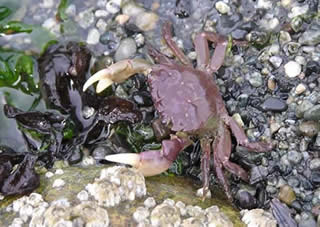

NATURE NOTES

Purple Shore Crab, photo by Hugh Griffith
Low Tide Marks
by
I took my five-year-old son to the beach at Spanish Banks. As we came up behind a couple perched on a log, he announced, "Something smells stinky!" The couple turned and laughed.
"That, my boy, is the ocean. It’s a good kind of stinky. Let’s go find some creatures." The tide was out, and there were acres of mud and barnacle-encrusted rocks. Each rock was the hiding place of innumerable small invertebrates, hunkered down in the dark and damp, awaiting the tide’s return.
The first rock turned resulted in the usual scurrying of tiny shrimp-like amphipods, and, thrill of thrills, a purple shore crab, the size of a nickel. Crabs are great – large or tiny, they’re always feisty. I offered my finger and it pinched for all it was worth.
I tried to explain barnacles to my son, but I don’t think it made sense. Barnacles are crustaceans that early in their development cement themselves to a solid object, form a plated skeleton, and spend the rest of their lives waving their feathery legs around, snatching plankton from the water. When the tide is out, they are sealed shut. If you place barnacles in a pail of seawater they will eventually open and start kicking. It’s a fun and relatively innocuous way to show sea life to a child, or anyone. Make sure to return them below high tide level.
The challenge in studying intertidal animals is doing it in a non-damaging way. No matter how careful you are, every footfall may mean the death of something, and every rock turned can lead to a very local catastrophe as it is placed back down.
I worked at an ocean park where groups of school children came to learn about intertidal life, and, after stern instructions on mudflat etiquette, would be released to find the same animals I was showing my son at Spanish Banks. I remember one child standing petrified among the rocks. She had taken the instructions so much to heart that she was afraid to move, in fear of hurting anything.
It’s a dilemma: How to investigate the splendiferous life around us without harming it?
When you are with a single five-year old, you pick him up and carry him back to shore, knowing only one of you is stepping on other lives, which is a bad kind of stinky.
Hugh Griffith is a BC zoologist and science writer.
Please cite these pages as:
Author, date, page title. In: Klinkenberg, Brian. (Editor) 2021. E-Fauna BC: Electronic Atlas of the Fauna of British Columbia [www.efauna.bc.ca]. Lab for Advanced Spatial Analysis, Department of Geography, University of British Columbia, Vancouver. [Date Accessed]
© Copyright 2021 E-Fauna BC.